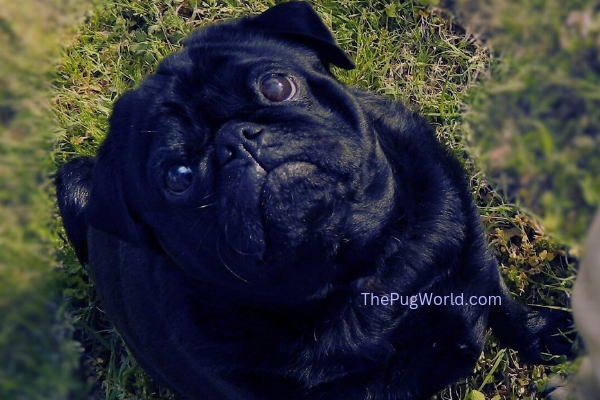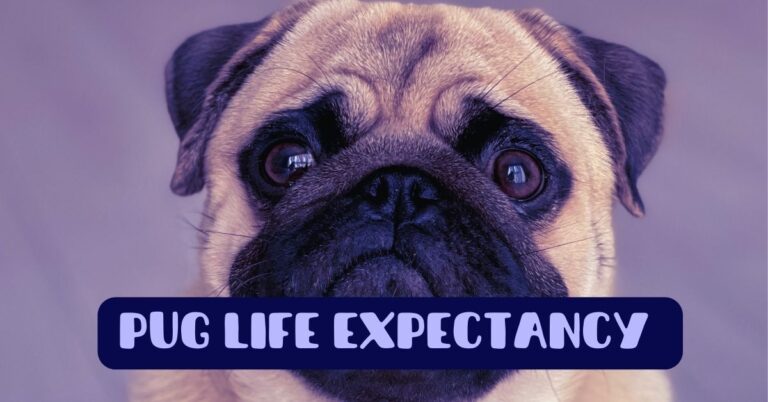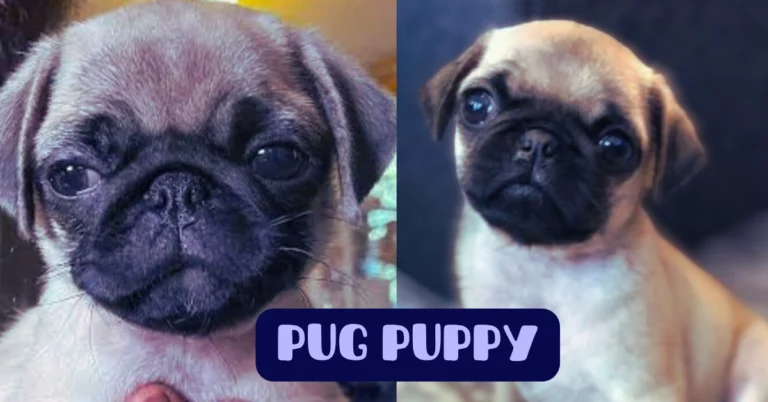You seem to have an interest in pug dogs and trying to know more about pug life expectancy, so take a moment to read this article.
If you’re drawn to the playful wrinkles and charming snorts of a pug, you’re not alone! These adorable companions bring endless joy to innumerable families.
To know more about pugs, you can read interesting facts about pugs.
But like all furry friends, their time with us is precious.
Having been a pug parent for several years, I would like to discuss various aspects of pug life, including pug life expectancy, factors influencing their lifespan, common health issues, typical causes of pug mortality, and signs indicating a pug may be nearing the end of its life.
So lets dive into the wonderful world of pugs, know more about life span of pugs, focusing on their health and well-being.
Pug Life Expectancy AKC
As per the American Kennel Club the average lifespan of a pug is typically around 13 to 15 years, regardless of gender.
This is slightly more than the average dog lifespan which is 10-13 years.
Pug Life Expectancy Male
The pug life expectancy is 13 to 15 years, regardless of gender.
Pug Life Expectancy Female
Just as male pugs, female pug life expectancy is 13 to 15 years.
Though as per few reports and studies, female pugs live slightly longer than male pugs.
The average lifespan for a female pug is often quoted as 13.2 years, while male pugs are around 12.8 years. However there is no definitive scientific proof for the same.
It is important to note that pugs life span may vary individually, and factors such as genetics, diet, exercise, healthcare, and overall care can influence life expectancy of a pug.

Pug health problems
Pugs are adorable companions, but unfortunately, they are also prone to several health issues due to their unique physical characteristics.
Addressing these concerns increases average lifespan of a pug and requires a combination of preventive measures, regular veterinary check-ups, and prompt intervention when needed.
Here are some common pug health problems that can influence pug life expectancy and some strategies how to address them:
- Respiratory issues:
Brachycephalic Obstructive Airway Syndrome (BOAS) is a very common and serious health problem in pugs.
The pugs can face difficulty in breathing due to their flat faces and short snouts, specially in hot weather or after strenuous activities, which can affect the pug life expectancy.
This can lead to serious complications like heat stroke or respiratory distress if not intervened at the correct time.
In severe cases corrective surgery is recommended to address the pugs anatomical issues.
So look out for signs such as labored breathing, excessive panting, snoring or noisy breathing and take action immediate.
Keep your pugs in cool weather, avoid exertion , maintain a healthy weight and go for regular checkups to identify underlying problems early on thus increasing pug life expectancy.
- Heating issues:
Pugs are brachycephalic in nature and this makes them sensitive to heat, affecting the pug life expectancy.
Their short snouts may look adorable but makes it difficult for them to breathe in. Pugs like other brachycephalic breeds may have difficulty in regulating their body temperature leading to heat related issues.
Excessive panting, drooling, glazed eyes, weakness, vomiting are some signs that means your pug is overheating.
In rare cases it may even lead to heat stroke.
Immediately seek veterinary attention if you suspect that your pug is experiencing heat stress or heatstroke.
Limiting outdoor activities in hot and sunny weather, providing shade and access to cool water, avoiding over exertion are some of the preventive measures that you can take which increase pug life expectancy.
Never leave your pug in a parked car as cars tend to get heated quickly.
- Eye problems:
The big protruding eyes of pugs may be a concern for this mischievous breed as they may easily hurt their eyes while playing. Red eyes, squinting or discharge may occur due to eye ulcers, infection or dry eyes.
Look out for any above mentioned symptoms, and immediately contact a vet if you detect them.
Keep the eyes and facial folds clean and trim hairs around the eyes.
Use protective eye wear during walk on windy days.
- Ear problems:
The adorable, folds of a pugs ears can trap dirt, debris and moisture. So bacteria and germs can flourish in a pugs ear leading to severe infections.
Look out for signs such as excessive head shaking or scratching, redness , swelling or discharge , or unpleasant odor from the ears.
Clean their ears regularly with a vet approved cleaner. Dry the inner folds of the pugs ear, specially after a bath or swim and visit the vet regularly.
- Skin problems:
However adorable the cuddly pug may be, it comes with a cost. The folds and wrinkles in skin can collect dirt and germs and lead to skin infection.
Pugs are prone to allergies due to environmental allergens like pollen or certain food, and can be super itchy and uncomfortable.
Overheating in hot weather can lead to red inflamed patches on skin.
The key is to keep the pug absolutely dry and clean using a dog friendly shampoo regularly .
Keep your dog cool in hot season and look out for redness and skin irritations.
Regular vet checkups are mandatory and can help you spot skin infections early and treat them properly.
- Joint Problems:
Joint problems like Patellar luxation and hip dysplasia are common in pugs. They can be painful and affect their mobility.
Other joint problems like the Legg-Calvé-Perthes Disease and Elbow Dysplasia are also seen.
Regular moderate exercise, proper diet, weight management, avoiding strenuous activities and regular vet visits are important.
- Other Concerns affecting Pug Life Expectancy:
Pug Dog Encephalitis (PDE):
Also known as necrotizing meningoencephalitis (NME), this is a fatal neurological disease in young pugs, directing affecting pug life expectancy.
This brain disease causes rapid and severe damage to the nervous system, leaving very little hope for recovery.
Mild or severe seizures are a common symptom, accompanied by other neurological abnormalities.
Consult with your vet in case of any such symptoms and provide love and support to your furry companion.
Dental issues:
Pugs generally have dental issues so it is important to take proper care.
Brush their teeth daily, provide dental chews and treats and do professional check ups regularly.
Recommended Health Tests From the National Breed Club:
These medical tests may help increase pug life expectancy if addressed at the correct time:
- Hip Evaluation
- Eye Examination by a board Certified ACVO Ophthalmologist
- Patellar Luxation
- Pug Dog Encephalitis (PDE) – DNA Test
How to raise a healthy pug
You can increase pug life expectancy by giving them extra love , care and attention due to their unique features. Raising a healthy pug includes proper nutrition, adequate exercise, routine checkups and attentive care. The following are some guidelines to raise a healthy pug.
Balanced Diet and Regular exercise:
As stated by AKC, the pug should do well on a vet approved high-quality dog food, whether commercially manufactured or home prepared. The pug should have access to clean fresh water all the time.
While regular exercise, moderate walks and playtime is important, care should be taken that the pug is not subjected to strenuous activities and hot weather conditions.
The aim is to maintain a healthy weight as pugs are prone to obesity which can lead to several health issues.
Grooming and Addressing specific needs:
Regularly clean the folds in skin and brush with a medium-bristle brush to keep the coat smooth and shiny. Trim nails regularly.
Clean with a a ears with a vet-approved cleaner and maintain area around eyes clean.
Maintain good oral health by brushing teeth regularly and provide dental chews and treats.
Immediately visit the vet if you suspect something is not okay with your pug.
Routine Veterinary Care:
Regular vet visits are important to detect and manage any potential health issues thus increasing pug life expectancy.
Vaccinations should be given timely.
Socialization and Mental Stimulation
AKC recommends early socialization and puppy training classes. This will develop their confidence and social skills.
Keep them mentally active by providing interactive toys, food puzzles and more.
Each pug is unique, so keep activities that suits your pugs interest and comfort level.
Love and Care
Pugs thrive in a loving and supportive environment. So spend quality time with your furry friend and give them plenty cuddles and playtime.
A pug loves care and attention and feels unhappy if his family regularly leaves him alone at home for long hours.
Choose a responsible breeder:
Do your own research and select reputable breeders who prioritize pug health over anything else.
Choosing a responsible breeder is important for all pug colors, both common and rare, to maintain breed standards and minimize health risks.
Instagram post shared by @pugloulou and @pugmosy
Senior pug care
Pug dog expectancy is 13 -15 years on an average, and pugs are considered seniors at the age of 7-9 , though it may vary based on individual health and genetics .
Like all other breeds, senior pugs tend to slow down with age. Their eyesight may decrease, hearing may become problematic. Their energy levels diminish and they may prefer frequent naps than engaging in different activities.
Stiff joints, arthritis and other age related issues are common in senior pugs.
You need to be patient and provide extra love, comfort and guidance to your furry friend.
He may have different nutritional needs, so adjust his diet accordingly. Do light exercise that suits his energy level.
Create a warm and comfortable living environment, adjusting with their physical needs.
Regular health checkups become even more important. Discuss with your vet and make a tailored plan so that your pug remains happy and healthy throughout their life.
Understanding and patience are key. They may no longer possess boundless energy of their younger selves, but their hearts are still filled with love and compassion. Provide lots of cuddles and positive reinforcement to your senior friend.
Understand that your pug may have to face end of life decisions. So take extra effort and time to ensure their golden years exceptionally special and memorable.
Instagram post shared by Vintage Pug Senior Sanctuary (@vintage_pugs)
FAQ
What’s the average life expectancy of a pug?
As per the American Kennel Club the average pug life expectancy is typically around 13 to 15 years.
What is the life expectancy of a male pug?
Male pugs, like their female counterparts, have an average lifespan of 13-15 years. Providing your pug with proper care, regular veterinary check-ups, a balanced diet, and a healthy lifestyle can contribute to a longer and healthier life.
What is the life expectancy of a chihuahua pug mix?
The life expectancy of a chihuahua pug mix or chug is 10 -13 years. This may vary depending on individual pug genetics, lifestyle and healthcare.
What age is a pug considered a senior?
The age at which a pug is considered a senior can vary, but generally falls between 7- 10 years. This is just an approximate as each pug ages differently.
How long do female pugs live?
On an average pugs have a lifespan of around 13 to 15 years regardless of gender. Some pugs may live longer, while others may have a shorter lifespan.
The lifespan of a female pug, like that of any dog, can vary depending on various factors such as genetics, overall health, diet, exercise, and veterinary care.
Conclusion
By providing your pug with the best possible care, you can increase pug life expectancy and their chances of living a long and happy life.
Pugs are a small breed and need regular care and attention.
Nutritious diets, regular exercise, routine heath check ups play a crucial role in increasing pug life expectancy.
With proper love and care your pug can enjoy a happy and healthy life throughout their lifespan.




